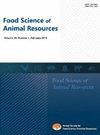Muscle fiber, connective tissue and meat quality characteristics of pork from low birth weight pigs as affected by diet-induced increased fat absorption and preferential muscle marbling
IF 3.7
3区 农林科学
Q2 FOOD SCIENCE & TECHNOLOGY
引用次数: 0
Abstract
This study investigated how birth weight differences in piglets affected carcass and muscle fiber properties as well as meat quality at slaughter. Within litters, piglets were grouped according to their birth weight as either normal (NBW; 1.62-1.73 kg) or low (LBW; 1.18-1.29 kg). At 5 weeks old, NBW piglets were randomly transitioned to control (C) or isocaloric high fat diets derived from non-dairy (HF), while LBW piglets were randomly transitioned to high fat diets derived from non-dairy (HF) or dairy sources (HFHD). Piglets were reared in individual pens under standardized housing and feeding conditions. Live weight was recorded weekly, and pigs were slaughtered at 12 weeks of age. Hot carcass weights, dressing percentages, lean meat yield, and primal cut proportions were determined. The m. longissimus thoracis was collected from the right side of the carcass for measurement of physical and chemical properties of meat and muscle fiber characteristics. Results indicated that LBW pigs compensated for their live weight compared to NBW pigs at 6 weeks of age. The mean muscle fiber diameter of LBW-HFHD group is significantly higher than NBW-C and NBW-HF group, and the type I muscle fiber diameter is significantly higher than NBW-C group. Dairy fat inclusion in LBW pig diet reduced carcass back fat thickness. This increased the calculated lean meat yield to be comparable to that of NBW pigs fed a commercial diet. Incorporating dairy sources high fat into LBW pigs低出生体重猪肌肉纤维、结缔组织和肉质特性受日粮诱导的脂肪吸收增加和优先肌肉大理石纹的影响
本研究探讨了仔猪出生体重差异对胴体和肌纤维性能以及屠宰时肉质的影响。在窝中,根据仔猪的出生体重分为正常(NBW;1.62-1.73 kg)或以下(LBW;1.18 - -1.29公斤)。在5周龄时,NBW仔猪随机过渡到对照(C)或来自非乳制品(HF)的等热量高脂肪饲粮,而LBW仔猪随机过渡到来自非乳制品(HF)或乳制品源(HFHD)的高脂肪饲粮。仔猪在标准化的猪舍和饲养条件下单独饲养。每周记录活重,12周龄屠宰。测定热胴体重、屠宰率、瘦肉产量和原始切割比例。取胴体右侧胸最长肌,测定肉的理化性质和肌纤维特性。结果表明,6周龄时,与NBW猪相比,LBW猪对其活重进行了补偿。LBW-HFHD组平均肌纤维直径显著高于NBW-C组和NBW-HF组,其中I型肌纤维直径显著高于NBW-C组。低体重猪日粮中乳脂肪的添加降低了胴体背部脂肪厚度。这提高了计算的瘦肉产量,与饲喂商业日粮的NBW猪相当。低体重猪中乳源高脂肪的掺入
本文章由计算机程序翻译,如有差异,请以英文原文为准。
求助全文
约1分钟内获得全文
求助全文
来源期刊

Food Science of Animal Resources
Agricultural and Biological Sciences-Animal Science and Zoology
CiteScore
6.70
自引率
6.70%
发文量
75
期刊介绍:
Food Science of Animal Resources (Food Sci. Anim. Resour.) is an international, peer-reviewed journal publishing original research and review articles on scientific and technological aspects of chemistry, biotechnology, processing, engineering, and microbiology of meat, egg, dairy, and edible insect/worm products.
 求助内容:
求助内容: 应助结果提醒方式:
应助结果提醒方式:


